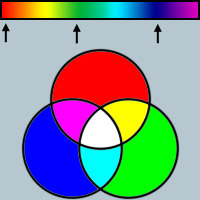
As you probably know... a given color of light can generally, be described by one number (e.g., the frequency of its wave length).
The color white, however, has no associated frequency; it is composed of equal amounts of all the (visible) frequencies of light. Black, of course, is the absence of light. And various shades of grey are generally composed of various intensities of white (as you lower the overall intensity of white, the grey gets darker and approaches black).
The question is: why is light (optically) additive? More specifically, why is it that when we add Red and Green together we get Yellow; Green and Blue together, we get Cyan; Red, Green, and Blue together, we get white?
(Please don't confuse this with the subtractive quality of pigments/paints, where as we add more colors, particularly more of the primary colors red, yellow, and blue, we approach black.)
Could we use three (or more) different colors and achieve the same result?
You people are going to start to hate me if I am not careful.
If you'll notice when working with various programs (paint for example) they prove all your statements above. The thing about light is that it has a sort of cancelling property to it. I know you said not to bring pigment into this, but it may help some. I say it is cancelling only because nothing is absorbed when we see white light and so we say (among the commoners) that black is a color and white is not. Now here's the thing, it would work to use different colors in order to obtain white under a few conditions. The first condition is that they must be the same intensity (not in appearance, but in actual wavelengths). The second condition is that none of the colors are opposites of each other in the color spectrum of light.
This Spectrum goes ROYGBIV... that is to say red, orange yellow, green, blue, indigo, violet. I personally don't like to include indigo because it is just a dark bluish color. That is not important though. if you will observe, red fades through orange into yellow. then yellow fades through green to get to blue, and if the spectrum repeated itself, blue would fade through violet to get to red. These colors (red yellow and blue) are the main colors, sort of. I was told to avoid pigment though, so I shall try from here on in.
The reason red light and green light make yellow is simply that yellow has a greater frequency presence between the colors than any other color between them, including orange, gold, and peach. The same is true with blue and green making cyan. The reason a full combination creates white is that when you add more light to something (even light of a different color) it gets brighter. the color you actually get from lower intensities of light is not actually grey, but rather a dimmer white. Part of the reason we see it as grey is that not all the light that hits a surface is reflected. The more light is reflected from a "grey" surface, the less "grey" it looks. The more light is absorbed, the less "dim white" it looks.
My problem with this is simply that well, light is very confusing, but there is your solution.
|
|
Posted by John
on 2004-12-17 06:21:42 |
 As you probably know... a given color of light can generally, be described by one number (e.g., the frequency of its wave length).
As you probably know... a given color of light can generally, be described by one number (e.g., the frequency of its wave length).



